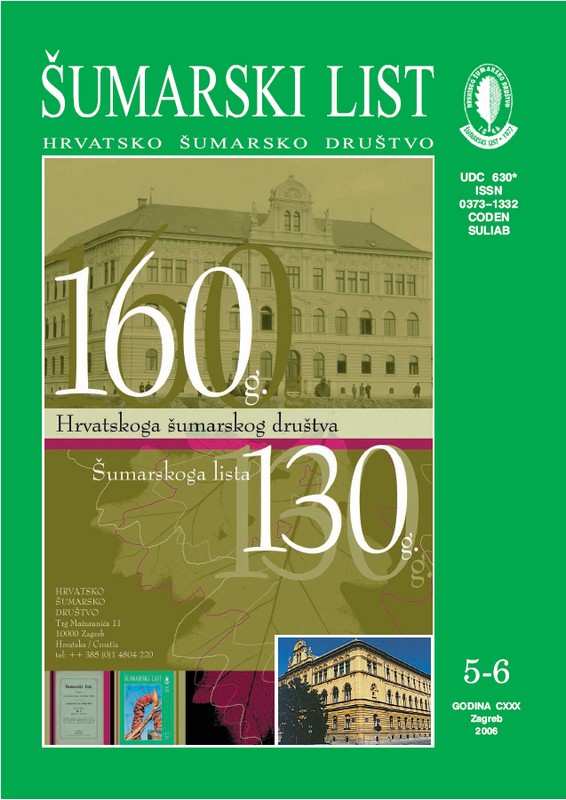
broj: 5-6/2006
pdf (30,9 MB) |
|
||||||||||||||
| IZVORNI ZNANSTVENI ČLANCI | ||
| CEROVEČKI, Zdravko | UDK 630* 188 (001) | |
| Seslerio sadlerianae-Ostryetum Cerovečki ass. nov. (Ostryo-Carpinion orientalis Ht. 1959) in the Mountains of the Northwestern Croatia pdf HR EN | 175 | |
| Bobinac, Martin | UDK 630* 242 (001) | |
| Effects of Thinning on the Increment of Trees in Different Biological Positions in i Middle-Aged Beech Stand pdf HR EN | 183 | |
| PREGLEDNI ČLANCI | ||
| Schneider-Jacoby, Martin | UDK 630* 263 + 148.2 + 907.1 | |
| The Sava and Drava Floodplains: Threatened Ecosystems of International Importance pdf HR EN | 193 | |
| PRETHODNO PRIOPĆENJE | ||
| Dubravac, T., V. Krejči, B. Vrbek | UDK 630* 231 + 181 + 114.3 | |
| Structure and Development of a 161 Year-old Spruce Culture pdf HR EN | 219 | |
| Summary: For the purpose of monitoring the natural course of development of a planted stand, in 1956 J. Šafar established a permanent experimental plot in a spruce culture. Based on an analysis of 16 spruce trees in 1957, the culture at the time of establishment of the plot was 113 years old, which indicates that the stand was planted in 1843. The plot was established in the “Delnice” Forest Office, Management Unit of Delnice, in the region of Velika Rebar-Sović laz. The plot was used to monitor the natural stand structure development and reforestation of the stand in the period from 1956 to 2004. The area, prior to planting of the spruce, had been a meadow (grass cutting) pasture. The culture was very well preserved which can be attributed to the forest management of the aristocrats Thurn-Taxis (landowners) from 1872 to 1939. The plot borders with a natural forest of beech and fir (Omphalodo-Fagetum Marinček et al, 1992) on dolomite. The immediate vicinity of these stands is reflected in the return of beech, maple, fir and other tree species and shrubs to their original site, which man had transformed into a hayfield-laz and 161 years ago into a spruce culture. The spruce culture during the observed period, and during five successive measurements (1956, 1957, 1962, 1994 and 2004) had unimodal distribution of d b h (number of trees) characteristic of even-aged stands. Distribution of the understory beech and some fir, later ingrown into the spruce culture, showed decreasing distribution of d b h characteristic of selection stands. Measurement of young growth showed that the number of the fir seedling plants during the last ten years (1994–2004) increased by almost 100 % (from 4 700 to 8 950 plants per ha), although not one exceeded 30 cm in height. The number of beech young plants was insufficient (1 250 plants in 1994 and 950 plants in 2004 per ha), of extremely poor quality. In the development stage of seedling plants and young plants maple appeared in greater numbers. However, because of the excessive crown cover over soil by the spruce and beech, amounting to 88 %, and browsing by wild game, it did not achieve reforestation of higher quality. A young spruce stand, under canopy, formed from the seeds of the old spruce culture, exists on the neglected meadow, in a frost-exposed site in the vicinity of the experimental plot. Parental material of dolomite conditions a series of soils: rendzina-brown soil on dolomite – luvisol. Luvisols occur predominantly in sinkholes, while rendzinas and brown soils on dolomite are found on the steeper slopes and on the crests. Brown soils on dolomites are predominant amounting to around 50 %, rendzinas participate with 30 %, and luvisols in sinkholes amount to 20 %. Results achieved from the chemical and physical analyses indicate that the soils from the natural fir-beech stand and meadow are richer with nutrients and humus than the soils from the spruce culture. In view of the present state of the structure and lack of management interventions during the last 42 years, future investigations should be directed in two parallel directions. Namely, monitoring the natural course of spruce culture development and monitoring the success of reforestation by the application of combined methods of reforestation on small areas (groupwise and nestwise) and development of these stands into beech-fir stands. Key words: beech; crown cover; fir; natural reforestation; pedological analyses; spruce; stand structure; young growth | ||


